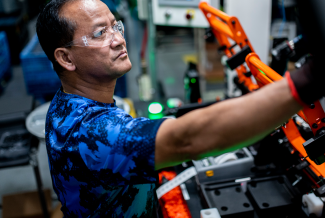What Is a Smart Factory?
Learn everything you need to know about smart manufacturing and how you can implement it into your processes.
Watch a Demo
The smart factory is a concept for expressing the end goal of digitalization in manufacturing. It is commonly used to describe a factory floor that uses Industry 4.0 technology to collect and share data on machines, devices, and production systems. This data is collected in real-time and is used by management to monitor the efficiency of certain processes, address issues, and improve productivity. A smart factory can monitor its entire production process, from machinery and the supply chain to operators who work on the shop floor.
Industry 4.0 Technologies Used in Smart Manufacturing
A smart factory uses various Industry 4.0 technologies to make manufacturing practices fully comprehensive. The focus is to deploy a series of technologies that will connect your entire manufacturing process and upload data into one safe and secure location. These technologies include:
Cloud Computing
The cloud gives companies a safe and secure location to store all the data gathered by the connected machines and devices used in their manufacturing. Cloud computing has greater flexibility and is more cost-effective than traditional on-premises alternatives. Quickly uploading large amounts of data helps management make decisions near real-time, identifying issues and correcting inefficiencies as fast as possible.
Big Data Analytics
Big data analytics uses artificial intelligence (AI) to spot error patterns and run predictive quality assurance with high accuracy. With the sheer amount of data uploaded to the cloud, it would be impossible for a human to conduct fast, accurate analysis. Big data analytics is used for predictive maintenance. AI uses machine learning and past data to spot error patterns that lead to downtime, then uses these patterns to predict and schedule maintenance before faults occur. This reduces downtime, which increases productivity and saves money. Delivering the right information at the right time allows shop floors to improve optimally and at speed.
Sensors
Sensors are attached to devices and machines to collect data at different stages of the manufacturing process. This information is uploaded to the cloud and analyzed using machine learning to provide instant visibility for management teams over the various layers of the shop floor. Temperature sensors are used in cleanrooms to track and detect climate in the lab, this data is shared through an Internet of Things (IoT) gateway and AI is used to self-correct or alert relevant teams of any changes.
Industrial Internet of Things
Industrial Internet of Things (IIoT) refers to all the machines and devices used in manufacturing that are linked by data communication systems on the internet. Using IIoT devices allows for the exchange and use of data between people and machines. These machines use sensors to collect data at different layers of the shop floor and the data is used to improve a company’s manufacturing processes. IIoT devices enable operational efficiency, control, and visibility over different stages of manufacturing.
Four Levels of Smart Factory Evolution
When considering smart factory implementation, four levels of data structure can help you evaluate your progress to becoming a smart factory. The four levels of smart factory evolution help businesses understand the steps they must take to advance to the next level of a smart factory.
-
Level One: Connected Data
Level one means that data is available, but not accessible. The first step to enabling a smart factory is to connect your data and integrate the different data sources into one location that continuously gathers and tracks real-time production. This is where cloud computing comes in to play. With easy access to data stored centrally, engineers can work to increase plant productivity by responding and resolving issues quickly. At level one, implementing improvements still requires lots of time, effort, and engagement from engineers, this is time-consuming, and businesses can be limited by available resources. To move to the next level, manufacturers must use AI and machine learning to enable predictive and prescriptive analytics.
-
Level Two: Predictive Analytics
Level two switches manufacturing from reactive problem solving to proactive analysis and improvement. AI and machine learning are used to track data patterns, identify issues or quality failures, and take preventative action to avoid downtime. These additional systems help visualize data and display dashboards. Proactive analysis reduces significant downtime and takes certain responsibilities off the engineers involved in the manufacturing process; however, it does still take considerable some time and effort. .
-
Level Three: Prescriptive Analytics
Active data means data that uses machine learning to perform proactive analysis and generate insights without human supervision. Level three uses active data to not only predict downtime before it occurs, but to recommend fixes and inform the relevant people of settings that allow the optimization of production. Using historical data, prescriptive analytics isolates the variables and production settings that contributed to the most profitable and least profitable runs. Information on these settings allows production teams to replicate their most efficient runs and convert years of best practices into processes that new operators can easily follow.
-
Level Four: AI-Driven Automation
The final level of a smart factory uses AI-driven automation to deploy the recommendations identified by analyzing manufacturing data. Level three sends the recommended changes to the relevant teams around the business, at level four, these changes are automatically executed. Achieving level four when considering smart factory implementation requires datasets that are large enough and have enough validated cases to provide the information systems need to understand the impacts of automated production change. This is still a technology for the future, and there will always be benefits to having an engineer review and accept recommendations before implementation. Once these are reviewed and accepted, however, certain dangerous implementation processes that were once left to an operator, can now be done using AI and machine learning technology.
Benefits of Smart Factory Technology
We’ve learned about what a smart factory is, but how can businesses benefit from implementation.
Leaner Processes
Businesses will benefit from deploying smart factory technology by seeing leaner processes. They can expect to save on order management costs and reduce material handling costs. A smart factory also results in lower inventory holding costs and the highest availability.
Maximum Flexibility
Smart factory technologies are engineered to adapt to different manufacturing environments and production setups. This ensures maximum operational flexibility.
Increased Agility
It’s important that manufacturing can adapt to changing customer demands in order to ensure productivity can meet demands and money is wasted on surplus resources. Smart factory technology recognizes manufacturing demand fluctuation and allows the supply chain to respond with better agility.
Improved Predictability
The ability to predict downtime before it becomes significant is an important benefit of smart factory implementation. Big data is used to identify patterns that lead to faults in manufacturing devices. Fixing these before they become a bigger problem saves businesses money and keeps the production line moving efficiently.
Proven Productivity
Smart factory technologies provide expertise for continuous, sustainable productivity improvement. They respond to supply chain changes, identify threats of machine downtime, and automate certain processes that free up engineers for other tasks around the business.
Plex’s smart manufacturing platform allows manufacturing teams to automate business processes and track data from the plant floor to the shop floor. You can learn more about how this single digital platform can improve your internal processes here.




